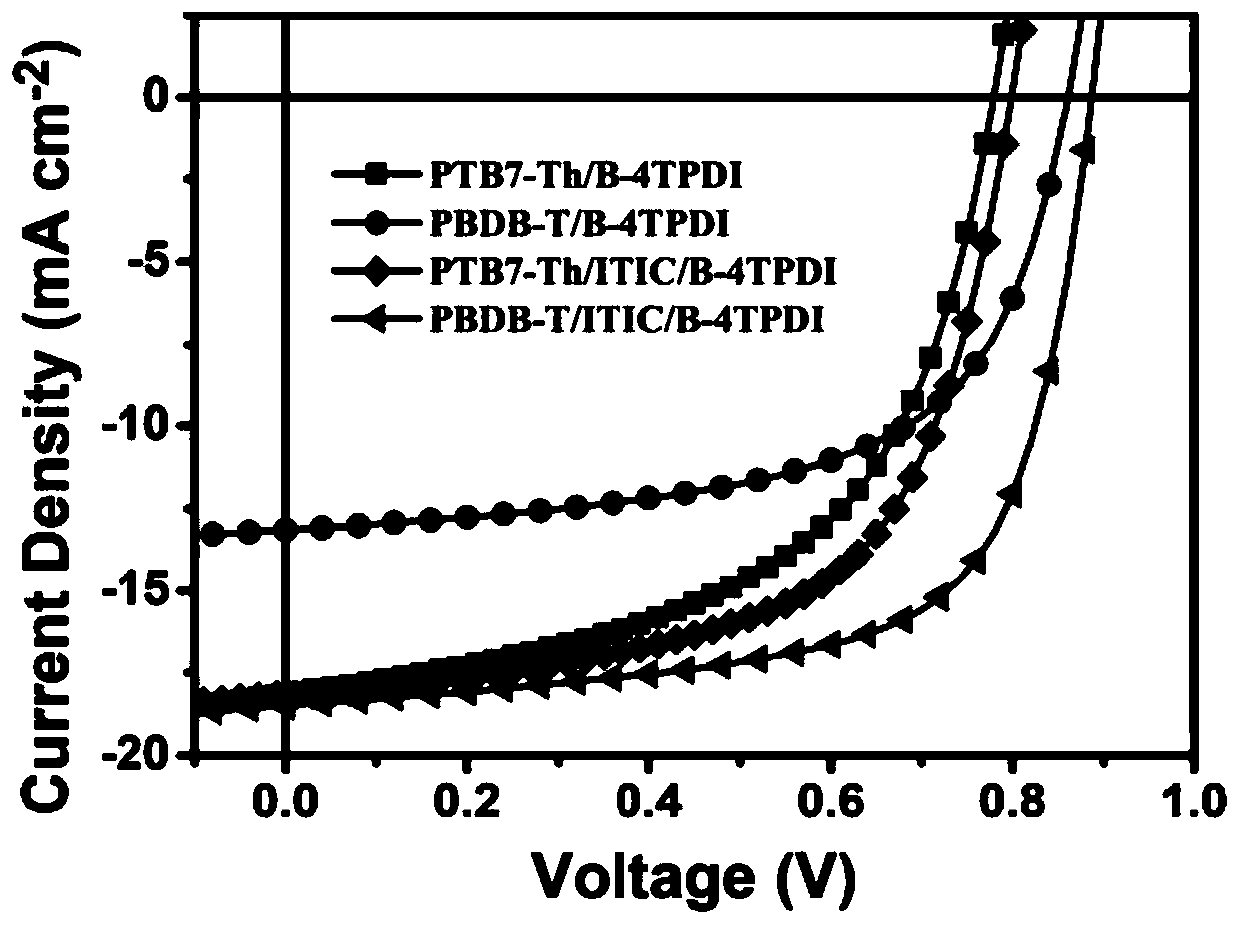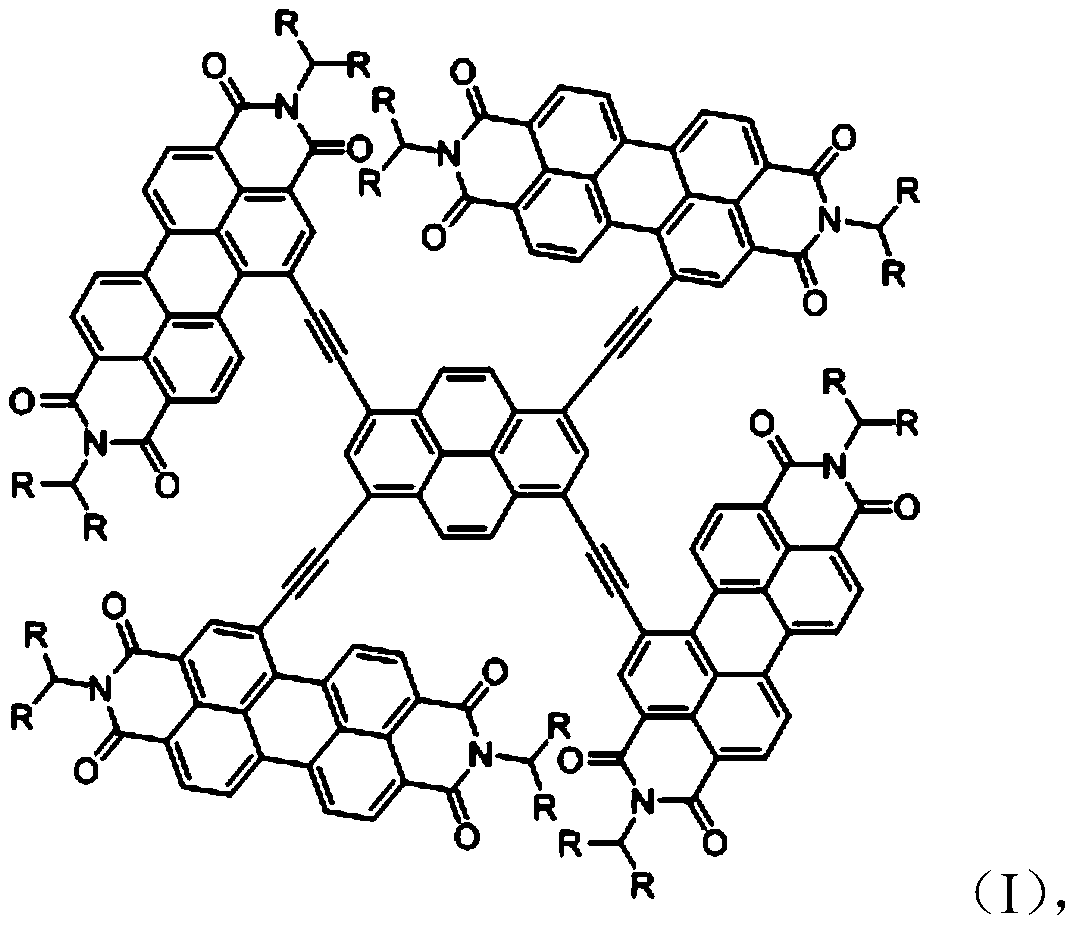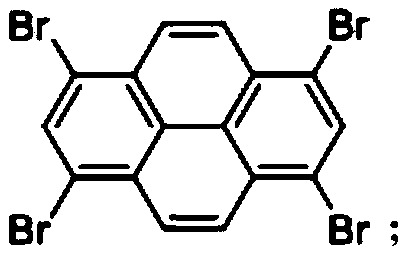Starburst non-fullerene organic small molecule receptor material containing pyrene and perylene diimide and preparation method of starburst non-fullerene organic small molecule receptor material
A technology of perylene diimide and small molecule acceptor is applied in the field of non-fullerene organic small molecule acceptor material and its preparation, which can solve problems such as low electron mobility, achieve good thermal stability and increase short-circuit current. Density and production cost reduction effect
- Summary
- Abstract
- Description
- Claims
- Application Information
AI Technical Summary
Problems solved by technology
Method used
Image
Examples
Embodiment 1
[0036] A non-fullerene organic small molecule acceptor material with the chemical structural formula B-4TPDI, its synthesis route is as follows:
[0037]
[0038] (1) Synthesis of intermediates with chemical structural formula a:
[0039] Add (517mg, 1mmol) 1,3,6,8-tetrabromopyrene, (588mg, 6mmol) trimethylsilylacetylene compound, (140mg, 0.2mmol) bis(triphenylphosphine) palladium dichloride, (52mg , 0.2mmol) triphenylphosphine, appropriate amount of cuprous iodide, mixed into 50mL toluene solution, N 2 Heat to 80℃ for 24 hours under protection; cool to room temperature, use CH 2 Cl 2 Extracted with water, anhydrous MgSO 4 Drying, filtering, and spin-drying the solvent; finally, column chromatography is performed with petroleum ether as the eluent to obtain an orange-yellow solid, which is the intermediate compound a, with a yield of 90%. 1 H NMR(400MHz, CDCl 3 ,δ / ppm): 8.57(s, 4H), 8.26(s, 2H), 0.38(s, 36H)
[0040] (2) Synthesis of intermediates with chemical structural formula b: ...
Embodiment 2
[0046] Preparation and photovoltaic performance test of binary solar cell based on non-fullerene organic small molecule B-4TPDI acceptor material:
[0047] First, clean the purchased ITO conductive glass: use the cleaning solution, ultrapure water, acetone, ethanol, and isopropanol to ultrasonically clean each for 15 to 30 minutes, then dry it in a drying oven at 100°C for 10 minutes, take it out, and cool. 15 minutes after UV ozone treatment. Then configure the ZnO precursor solution: Weigh a certain amount of zinc acetate dihydrate and ethanolamine, and dissolve them in 2-methoxyethanol to obtain a zinc acetate dihydrate concentration of 0.75 mol L -1 , The concentration of ethanolamine is 0.75mol L -1 The solution is then placed in a glove box and stirred at room temperature for more than 8 hours for use. Put the previously processed ITO conductive glass into a glove box with a water and oxygen index of less than 1PPM, spin-coat the ZnO precursor solution, take it out, and ann...
Embodiment 3
[0055] Preparation and photovoltaic performance test of ternary solar cell based on non-fullerene organic small molecule B-4TPDI acceptor material:
[0056] The process and method of solar cell preparation and photovoltaic performance test are the same as in Example 2, except that the active layer is changed to: (1) polymer donor PTB7-Th and 2 kinds of non-fullerene organic small molecules The blend solution of body B-4TPDI and ITIC (mass ratio 0.66:0.05:0.95) (concentration 20mg / mL); (2) polymer donor PBDB-T and two non-fullerene organic small molecule receptors B-4TPDI, ITIC (mass ratio 1:0.05:0.95) blending solution (concentration 20mg / mL), and adding 0.5% of 1,8-diiodooctane as an additive.
[0057] The molecular structure of another small molecule receptor ITIC used in the present invention is as follows:
[0058]
[0059] Based on the PTB7-Th: ITIC: B-4TPDI active layer solar cell, the test results are as follows figure 1 Shown: the open circuit voltage is 0.79V, the short-ci...
PUM
| Property | Measurement | Unit |
|---|---|---|
| Short circuit current density | aaaaa | aaaaa |
| Short circuit current density | aaaaa | aaaaa |
Abstract
Description
Claims
Application Information
 Login to View More
Login to View More - R&D
- Intellectual Property
- Life Sciences
- Materials
- Tech Scout
- Unparalleled Data Quality
- Higher Quality Content
- 60% Fewer Hallucinations
Browse by: Latest US Patents, China's latest patents, Technical Efficacy Thesaurus, Application Domain, Technology Topic, Popular Technical Reports.
© 2025 PatSnap. All rights reserved.Legal|Privacy policy|Modern Slavery Act Transparency Statement|Sitemap|About US| Contact US: help@patsnap.com



